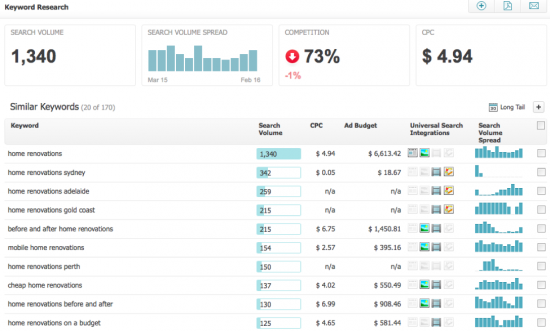“Google, what’s the best article that describes proof and relevant terms in search?”
In this and every Google query, search results attempt to understand both the topic you’re researching and the underlying intent of the search.
Digital marketers who rely on old-school keyword ranking strategies to boost their clients’ results are missing out. Google’s dual approach to delivering SERPs rankings now goes beyond the skin-deep (proof) and into the “I want to get to know you” territory (relevant).
While it used to be enough to build a piece of content around one or two specific keywords, don’t count on that working well in this new era of search. Given this state of change, it’s worth diving into how Google deciphers the theme of content, and how you can find appropriate words and phrases to build content around.
From individual keywords to latent semantic indexing
Since Google began using latent semantic indexing (LSI) to decipher the theme of content, targeting individual keywords has become a far less effective strategy for ranking. Instead of exclusively looking for specific keywords or phrases, Google is now able to determine the main theme of a piece of content by looking at the frequency of a variety of interrelated words and phrases.
This ability to detect patterns between words and phrases means that optimizing a page for one or two individual keywords is no longer enough. For instance, in a well-written article about content marketing, you would expect to see a number of related words and phrases like “blog,” “social media,” and, of course, “content and marketing.” When Google sees content that includes a variety of terms that make sense together, it’s more likely to be deemed high quality. It will return it in the search results for those words and phrases.
Does this mean you shouldn’t focus on any specific keywords or phrases?
Not at all. The problem arises when marketers attempt to use this strategy exclusively, without giving consideration to words and phrases that bolster the validity of a primary keyword.
The building blocks of LSI: Proof and relevant terms
In Searchmetrics annual search ranking factors report (the most recent one here), we discuss proof and relevant terms and their relationship to rankings. These terms are also sometimes referred to as LSI keywords.
These words or phrases are ones that are often (or even always) used in relation to each other. If a piece of content is going to rank for a particular keyword, those related words are more than likely going to be used as well.
Proof terms: These are the words or phrases that must be used in relation to a particular topic. For instance, on a page targeting the keyword phrase “search engine optimization,” you would most likely also find words like “Google,” “rankings” and “SEO.” These “relational” words prove that the content does a comprehensive job of covering the topic of search engine optimization.
Relevant terms: These are words and phrases that suggest a piece of content is holistic and of high quality. They don’t necessarily need to be present to prove the content is on point, but they certainly help. Using the example above, some relevant terms might be “content marketing,” “blogging” or “user experience.”
Depending on the specific angle your content is tackling, these words may or may not be used; but when these words are used, Google makes the connection between these words to draw conclusions as to your primary theme.
In analyzing the top 10 highest-rankings pages in the SERPs, the average proportion of proof terms on the page was 78 percent. This same proportion was found in the top 30 results. While the proportion of related terms wasn’t quite as high – coming in at 53 percent for the top 10 pages and 49 percent for the top 30 – the terms still remain an important ranking factor.
How to find proof and relevant terms for your content
It’s all well and good to say these are important elements for achieving high rankings. But many marketers and SEOs struggle to identify which words or phrases they should be using in their content.
Because there is no definitive list of words or phrases that Google deems as ‘related,’ there is still some degree of guesswork that needs to take place. However, many typical keyword research strategies apply here. Here are some ways you can identify both proof and relevant terms for your content.
1. Use your favorite keyword tools to find synonyms and sub-topics
Using keyword tools like Ubersuggest, Searchmetrics or Google’s Keyword Planner, plug in the main topic or theme of your content and look for related terms.
As far as finding proof terms, focus on finding synonyms, variations and terms closely related to your primary keywords. For instance, if my main topic was home renovations, I might use words like “reno,” “house” and “building.” Remember, you’re looking for terms that pretty much need to be present to write anything informative, interesting and complete about your topic.
The Searchmetrics keyword tool reveals “similar keywords” related to your primary keyword.
To find relevant terms, look for words and phrases that you can use as sub-topics for your main theme. These are terms that indicate you’re writing holistically, covering every angle of your topic. Using the example above, I might use words like “bathroom,” “granite” or “countertops.” These terms indicate the specific sub-topics my content will be covering, and will indicate to Google that my content is sufficiently in-depth and knowledgeable.
2. Go right to the source: Google Auto-Complete and Google Instant
If you want to see some of the keywords Google deems as related, I recommend using the “Searches Related To” feature at the bottom of the SERPs. Plug in your primary keyword, and see which other words or phrases Google (and users) think are closely matched.
Another strategy is to use Google’s autocomplete feature and Google Instant. Start typing your primary topic/keyword into the search box, and see which phrases appear in autocomplete. Keep an eye on Google Instant as well (the results Google automatically returns in the SERPs as you type) to see if any other words or phrases jump out.
3. Competitive keyword research
Since we know that proof and relevant terms are significant ranking factors, we can presume that the top-ranking pages for our keyword already contain a good mix of proof and relevant terms. Find top-ranked pages for your desired keyword, and then use a tool like SEO Book’s Keyword Density Analyzer to identify the words or phrases used most often on the page.
Repeat this process with all the top-ranking sites (at least the top three) to see if any keywords or phrases overlap. If you can identify a handful of terms that are used frequently on all the top-ranking pages, you’ll have a good arsenal of keywords to use in your own content.
Conclusion
Identifying and incorporating proof and relevant terms into your content is one of the best ways to write comprehensive content that ranks well. It’s also the key to writing in-depth content that provides the best possible user experience.
Resist the urge to optimize your content for a few primary keywords and call it a day. Using a wide variety of proof and related words and phrases will not only ensure you do a great job of covering your topic, it will give Google all the clues it needs to decipher the precise topic of your page.
How do you find proof and relevant terms for your content? Share your strategies below!





